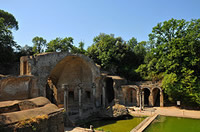 |
 |


 
|
| SIGHTSEEING – ROME SURROUNDINGS (TIVOLI GARDENS) |
| |
Starting time at 08:30 A.M. - 8 HRS TOUR |
.jpg)

|
The name Tivoli originally indicates the town of Tivoli in the Lazio region of central Italy, founded a few centuries before Rome
in 547, in the course of the Gothic War, the city was fortified by the Byzantine general Belisarius, but was later destroyed by Totila's army. After the end of the war it became a Byzantine duchy, later absorbed into the Patrimony of St. Peter. After Italy was conquered by Charlemagne Tivoli was under the authority of a count.
At first an independent ally of Rome, Tibur allied itself with the Gauls in 361 BC. Vestiges remain of its defensive walls of this period, in opus quadrata. In 338 BC, however, Tibur was defeated and absorbed by the Romans. The city acquired Roman citizenship in 90 BC and became a resort area famed for its beauty and its good water, and was enriched by many Roman villas. The most famous one, of which the ruins remain, is the Villa Adriana (Hadrian's Villa). From the 16th century the city saw further villa construction. The most famous of these is the Villa d'Este, begun in 1549 by Pirro Ligorio for Cardinal Ippolito II d'Este and richly decorated with an ambitious program of frescoes by famous painters of the late Roman Mannerism, such Livio Agresti (a member of the "Forlì painting school) or the Zuccari brothers. In 1527 Tivoli was sacked by bands of the supporters of the emperor and the Colonna, important archives being destroyed during the attack. In 1547 it was again occupied, by the Duke of Alba in a war against Paul IV, and in 1744 by the Austrians.
|
|
| OUR FLEET |
 |
 |
 |
Mercedes E Class
or equivalent up to 3 pax |
Mercedes Vito/Viano
or equivalent up to 5 pax |
Mercedes Sprinter
or equivalent up to 8 pax |
| 380 € |
420 € |
460 € |
Accepted payments: U.S. Dollars,Euro, Traveller's cheques.
Prices include driver guide for whole tour
Licensed Guide, Entrance Fees and Tips not included |
Possibility to hire a licensed guide at a “ SPECIAL PRICE " - qualified stores will be suggested for shopping: cameos & travertine marble
LUNCH ( price not included ) in a typical restaurant
|
|
|
| TIVOLI |
.jpg)

|
The name Tivoli originally indicates the town of Tivoli in the Lazio region of central Italy, founded a few centuries before Rome
The name of the city came to be used in diminutive form as Tiburi instead of Tibur and so transformed through Tibori to Tiboli and finally to Tivoli. But its inhabitants are still called Tiburtini and not Tivolesi.
In 547, in the course of the Gothic War, the city was fortified by the Byzantine general Belisarius, but was later destroyed by Totila's army. After the end of the war it became a Byzantine duchy, later absorbed into the Patrimony of St. Peter. After Italy was conquered by Charlemagne Tivoli was under the authority of a count,
At first an independent ally of Rome, Tibur allied itself with the Gauls in 361 BC. Vestiges remain of its defensive walls of this period, in opus quadrata. In 338 BC, however, Tibur was defeated and absorbed by the Romans. The city acquired Roman citizenship in 90 BC and became a resort area famed for its beauty and its good water, and was enriched by many Roman villas. The most famous one, of which the ruins remain, is the Villa Adriana (Hadrian's Villa). Maecenas and Augustus also had villas at Tibur, and the poet Horace had a modest villa: he and Catullus and Statius all mention Tibur in their poems. In 273, Zenobia, the captive queen of Palmyra, was assigned a residence here by the Emperor Aurelian. The 2nd-century temples of Hercules Victor is being excavated. The present Diazza del Duomo occupies the Roman forum.
From the 16th century the city saw further villa construction. The most famous of these is the Villa d'Este, begun in 1549 by Pirro Ligorio for Cardinal Ippolito II d'Este and richly decorated with an ambitious program of frescoes by famous painters of the late Roman Mannerism, such Livio Agresti (a member of the "Forlì painting school") or the Zuccari brothers. In 1527 Tivoli was sacked by bands of the supporters of the emperor and the Colonna, important archives being destroyed during the attack. In 1547 it was again occupied, by the Duke of Alba in a war against Paul IV, and in 1744 by the Austrians.
|
| |
|
|
 |
 |


![]()
![]()
![]()
.jpg)

.jpg)



